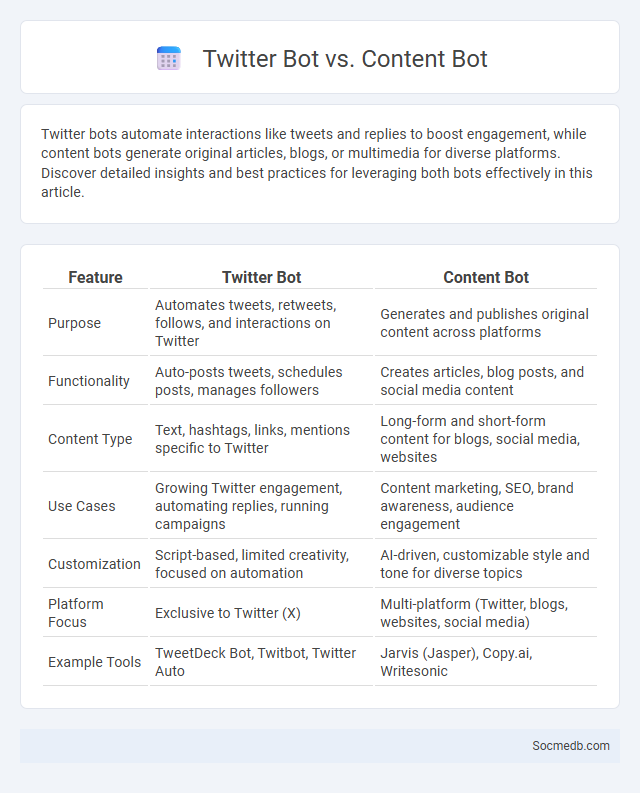
Photo illustration: Twitter Bot vs Content Bot
Twitter bots automate interactions like tweets and replies to boost engagement, while content bots generate original articles, blogs, or multimedia for diverse platforms. Discover detailed insights and best practices for leveraging both bots effectively in this article.
Table of Comparison
| Feature | Twitter Bot | Content Bot |
|---|---|---|
| Purpose | Automates tweets, retweets, follows, and interactions on Twitter | Generates and publishes original content across platforms |
| Functionality | Auto-posts tweets, schedules posts, manages followers | Creates articles, blog posts, and social media content |
| Content Type | Text, hashtags, links, mentions specific to Twitter | Long-form and short-form content for blogs, social media, websites |
| Use Cases | Growing Twitter engagement, automating replies, running campaigns | Content marketing, SEO, brand awareness, audience engagement |
| Customization | Script-based, limited creativity, focused on automation | AI-driven, customizable style and tone for diverse topics |
| Platform Focus | Exclusive to Twitter (X) | Multi-platform (Twitter, blogs, websites, social media) |
| Example Tools | TweetDeck Bot, Twitbot, Twitter Auto | Jarvis (Jasper), Copy.ai, Writesonic |
Understanding Bots: Definitions and Key Differences
Bots are automated software programs that perform tasks on social media platforms, ranging from content posting to user interaction. Distinguishing between types such as social bots, chatbots, and spam bots is crucial for understanding their impact on online engagement and misinformation. Key differences lie in their functions: social bots amplify messages, chatbots simulate conversations, while spam bots distribute unsolicited content.
What is a Twitter Bot?
A Twitter bot is an automated software application designed to perform specific tasks such as posting tweets, retweeting, liking, or following other accounts based on pre-set algorithms and rules. These bots operate on the Twitter platform to enhance engagement, disseminate information, or simulate user behavior without direct human intervention. Advanced Twitter bots can analyze trending topics and interact in real-time to amplify content reach and influence audience interactions.
Content Bots Explained
Content bots automate the creation and distribution of social media posts, using AI-driven algorithms to generate engaging, relevant material tailored to your audience's preferences. These bots optimize posting schedules and analyze interaction metrics to enhance reach and engagement efficiently. Leveraging content bots allows you to maintain a consistent online presence while saving time on content management.
The Broad Category: General Bots
General bots on social media perform automated tasks such as content sharing, user engagement, and data collection, often mimicking human behavior to influence trending topics and amplify messages. These bots can significantly impact platform algorithms by generating high volumes of interactions, thereby shaping public opinion and viral content dissemination. Understanding the role and behavior of general bots is crucial for detecting misinformation and maintaining the integrity of online interactions.
Use Cases: Twitter Bot vs Content Bot
Twitter bots automate engagement by posting real-time updates, retweets, and replies to increase follower interaction, making them ideal for dynamic brand presence and trend participation. Content bots generate blog posts, articles, and social media captions using AI, streamlining content creation for marketing campaigns and SEO optimization. Twitter bots excel in active communication within the platform, while content bots enhance volume and consistency of published material across multiple channels.
Automation Features: Comparing Bot Types
Automation features on social media platforms enhance user engagement and streamline content management by utilizing different bot types such as chatbots, scheduling bots, and analytical bots. Chatbots provide instant customer support and personalized interactions, while scheduling bots manage post timing to maximize reach. Analytical bots gather and interpret data to optimize content strategy, improving overall campaign effectiveness.
Ethical Considerations of Each Bot
Social media bots designed for marketing, customer service, or information dissemination raise significant ethical considerations including transparency, privacy, and manipulation risks. Ensuring bots clearly disclose their automated nature prevents deceptive interactions while safeguarding user data upholds platform trust and legal compliance. Ethical frameworks emphasize accountability in bot behavior to avoid spreading misinformation or exploiting vulnerable audiences across social media channels.
Advantages and Limitations: Twitter Bot vs Content Bot vs Bot
Twitter bots excel in real-time interaction and trend monitoring, enhancing user engagement through automated replies and retweets, but they risk spreading misinformation and can be detected as spam. Content bots efficiently generate large volumes of articles or posts using AI, saving time and resources, yet often lack nuanced creativity and may produce generic or low-quality content. General bots serve various automation tasks across platforms, improving workflow efficiency but facing limitations in understanding complex contexts and maintaining genuine user interactions.
Security Risks and Mitigation Strategies
Social media platforms expose users to security risks such as phishing attacks, identity theft, and data breaches that compromise personal information. Implementing strong, unique passwords, enabling two-factor authentication, and regularly reviewing privacy settings significantly reduce vulnerability. You should also remain cautious about sharing sensitive details and be vigilant for suspicious activities to safeguard your online presence effectively.
Future Trends in Bot Technology
Advancements in artificial intelligence and machine learning are driving the development of increasingly sophisticated social media bots capable of more natural and context-aware interactions. Future trends indicate a rise in hyper-personalized content delivery, automated customer service, and sentiment analysis to enhance user engagement and brand reputation management. Enhanced bot detection and ethical frameworks will play critical roles in balancing automation benefits with the need for transparency and authenticity on social media platforms.
 socmedb.com
socmedb.com